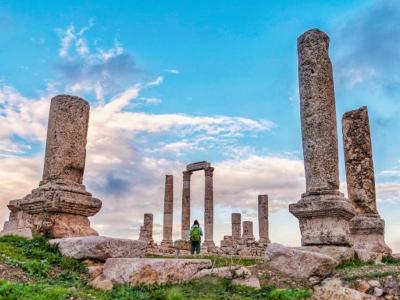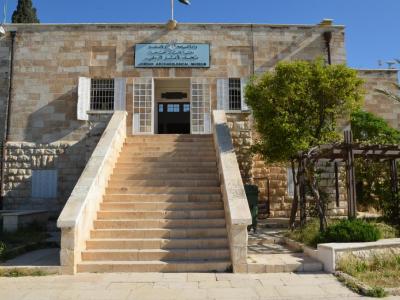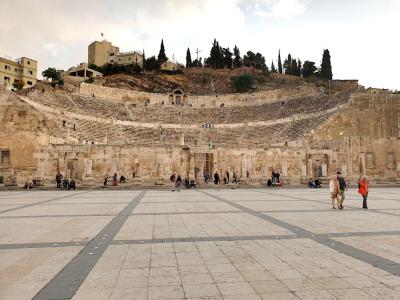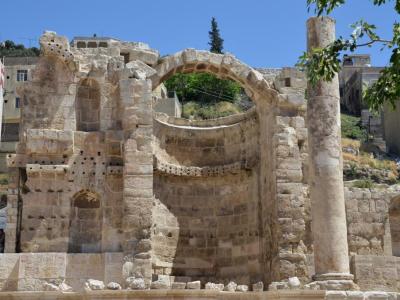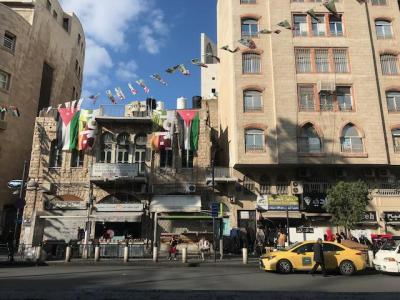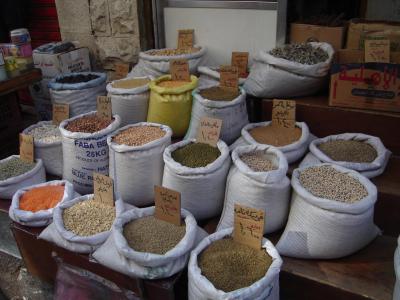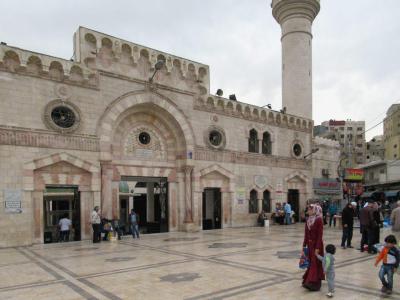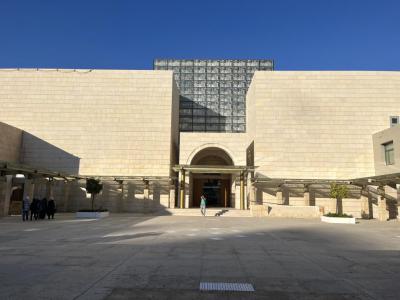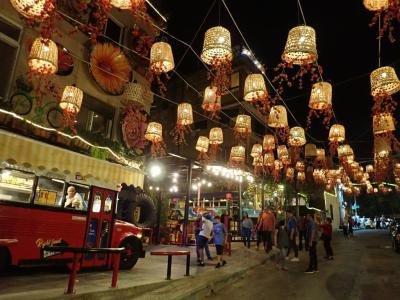Amman Introduction Walking Tour (Self Guided), Amman
The capital of Jordan, Amman, is a city that successfully marries rich history with the bustling vibrancy of a modern metropolis. A place where ancient tales and contemporary life intersect.
The earliest evidence of human settlement in the area dates back to the 8th millennium BC. Initially, in the second millennium BC, the city was known as Rabat Aman and served as the capital of the Ammonite Kingdom, centered in the Amman Citadel. In the 3rd century BC, Ptolemy II Philadelphus of Egypt, rebuilt the city and renamed it "Philadelphia" (which means "brotherly love" in Ancient Greek), thus making it a regional center of Hellenistic culture. Under Roman rule, Philadelphia was one of the ten Greco-Roman cities of the Decapolis and later became part of Arabia Petraea province, during which the Roman Theater and other landmarks were built.
The Rashidun Caliphate conquered the city from the Byzantines in the 7th century AD and recalled it Amman (a derivative of Rabat Aman).
Throughout most of the Middle Ages, Amman alternated between periods of devastation and abandonment and spells of relative prosperity as the center of the Balqa region. The city was largely abandoned from the 15th century until 1878 when Ottoman authorities began settling Circassians there. After the Ottoman Empire inaugurated the Hejaz railway station in 1904, Amman became connected to other nearby cities.
After its designation as Transjordan's capital in 1921, the city witnessed rapid growth. Initially built on seven hills, it now spans over 19 hills combining 22 areas. The hilly capital of Jordan boasts countless attractions and places to visit. East Amman is predominantly filled with historic sites that frequently host cultural activities, while West Amman is more modern and serves as the economic center of the city.
If you're interested in getting immersed in Jordanian culture, the local Archaeological Museum and Jordan Museum will have you covered. To experience Amman's contemporary life and people-watching, Rainbow Street can't be beaten. Religious landmarks also grace the cityscape, such as the Grand Al-Husseini Mosque standing tall as a symbol of Islamic architecture.
No matter what drove you to visit Jordan, don't overlook its charming capital city. It's an underrated destination worth at least a few days in your itinerary. You can really get a taste of the country and bask in the warmth of its welcoming people here. Amman awaits your exploration, ready to unveil its captivating secrets!
The earliest evidence of human settlement in the area dates back to the 8th millennium BC. Initially, in the second millennium BC, the city was known as Rabat Aman and served as the capital of the Ammonite Kingdom, centered in the Amman Citadel. In the 3rd century BC, Ptolemy II Philadelphus of Egypt, rebuilt the city and renamed it "Philadelphia" (which means "brotherly love" in Ancient Greek), thus making it a regional center of Hellenistic culture. Under Roman rule, Philadelphia was one of the ten Greco-Roman cities of the Decapolis and later became part of Arabia Petraea province, during which the Roman Theater and other landmarks were built.
The Rashidun Caliphate conquered the city from the Byzantines in the 7th century AD and recalled it Amman (a derivative of Rabat Aman).
Throughout most of the Middle Ages, Amman alternated between periods of devastation and abandonment and spells of relative prosperity as the center of the Balqa region. The city was largely abandoned from the 15th century until 1878 when Ottoman authorities began settling Circassians there. After the Ottoman Empire inaugurated the Hejaz railway station in 1904, Amman became connected to other nearby cities.
After its designation as Transjordan's capital in 1921, the city witnessed rapid growth. Initially built on seven hills, it now spans over 19 hills combining 22 areas. The hilly capital of Jordan boasts countless attractions and places to visit. East Amman is predominantly filled with historic sites that frequently host cultural activities, while West Amman is more modern and serves as the economic center of the city.
If you're interested in getting immersed in Jordanian culture, the local Archaeological Museum and Jordan Museum will have you covered. To experience Amman's contemporary life and people-watching, Rainbow Street can't be beaten. Religious landmarks also grace the cityscape, such as the Grand Al-Husseini Mosque standing tall as a symbol of Islamic architecture.
No matter what drove you to visit Jordan, don't overlook its charming capital city. It's an underrated destination worth at least a few days in your itinerary. You can really get a taste of the country and bask in the warmth of its welcoming people here. Amman awaits your exploration, ready to unveil its captivating secrets!
How it works: Download the app "GPSmyCity: Walks in 1K+ Cities" from Apple App Store or Google Play Store to your mobile phone or tablet. The app turns your mobile device into a personal tour guide and its built-in GPS navigation functions guide you from one tour stop to next. The app works offline, so no data plan is needed when traveling abroad.
Amman Introduction Walking Tour Map
Guide Name: Amman Introduction Walking Tour
Guide Location: Jordan » Amman (See other walking tours in Amman)
Guide Type: Self-guided Walking Tour (Sightseeing)
# of Attractions: 9
Tour Duration: 2 Hour(s)
Travel Distance: 4.3 Km or 2.7 Miles
Author: DanaOffice
Sight(s) Featured in This Guide:
Guide Location: Jordan » Amman (See other walking tours in Amman)
Guide Type: Self-guided Walking Tour (Sightseeing)
# of Attractions: 9
Tour Duration: 2 Hour(s)
Travel Distance: 4.3 Km or 2.7 Miles
Author: DanaOffice
Sight(s) Featured in This Guide:
- Amman Citadel
- Jordan Archaeological Museum
- Hashemite Plaza
- Roman Nymphaeum (Public Fountain)
- Duke's Diwan
- Souk Mango (Mango Bazaar)
- Grand Al-Husseini Mosque
- Jordan Museum
- Rainbow Street
1) Amman Citadel (must see)
The Amman Citadel, known locally as "Jabal Al-Qal'a," is an iconic archaeological site located in the heart of downtown Amman. Situated on an L-shaped hill, this historic site occupies one of the seven original hills, or "jabals," that formed the foundation of ancient Amman.
With a rich and storied past, the Amman Citadel has witnessed the occupation of numerous great civilizations throughout history. Its history dates back to the Neolithic period, with evidence of human settlement found at the site. Over time, the hill was fortified during the Bronze Age around 1800 BCE. It later served as the capital of the Kingdom of Ammon, a prominent kingdom that rose to power around 1200 BCE.
Throughout its history, the Citadel came under the control and influence of various empires, including the Neo-Assyrian Empire in the 8th century BCE, the Neo-Babylonian Empire in the 6th century BCE, and later the Ptolemies, the Seleucids in the 3rd century BCE, the Romans in the 1st century BCE, the Byzantines in the 3rd century CE, and the Umayyads in the 7th century CE.
Following the Umayyad period, the Citadel experienced a period of decline, and for much of the time until 1878, it remained abandoned and in ruins, occasionally used by Bedouins and seasonal farmers. Despite this gap, the Amman Citadel is recognized as one of the world's oldest continuously inhabited sites.
Today, most of the visible structures at the Citadel date from the Roman, Byzantine, and Umayyad periods. Key archaeological features include the Temple of Hercules, a Byzantine church, and the Umayyad Palace. Additionally, the Jordan Archaeological Museum, built in 1951, is situated on the hill and houses a rich collection of historical artifacts.
While the fortification walls enclose the central part of the site, the ancient periods of habitation covered extensive areas. Various historic structures, tombs, arches, walls, and stairways can be found without modern boundaries, offering significant archaeological potential. Archaeological work has been ongoing at the site since the 1920s, with contributions from Italian, British, French, Spanish, and Jordanian projects. Despite these efforts, a substantial portion of the Citadel remains unexcavated, promising further discoveries and insights into the fascinating history of this ancient landmark.
With a rich and storied past, the Amman Citadel has witnessed the occupation of numerous great civilizations throughout history. Its history dates back to the Neolithic period, with evidence of human settlement found at the site. Over time, the hill was fortified during the Bronze Age around 1800 BCE. It later served as the capital of the Kingdom of Ammon, a prominent kingdom that rose to power around 1200 BCE.
Throughout its history, the Citadel came under the control and influence of various empires, including the Neo-Assyrian Empire in the 8th century BCE, the Neo-Babylonian Empire in the 6th century BCE, and later the Ptolemies, the Seleucids in the 3rd century BCE, the Romans in the 1st century BCE, the Byzantines in the 3rd century CE, and the Umayyads in the 7th century CE.
Following the Umayyad period, the Citadel experienced a period of decline, and for much of the time until 1878, it remained abandoned and in ruins, occasionally used by Bedouins and seasonal farmers. Despite this gap, the Amman Citadel is recognized as one of the world's oldest continuously inhabited sites.
Today, most of the visible structures at the Citadel date from the Roman, Byzantine, and Umayyad periods. Key archaeological features include the Temple of Hercules, a Byzantine church, and the Umayyad Palace. Additionally, the Jordan Archaeological Museum, built in 1951, is situated on the hill and houses a rich collection of historical artifacts.
While the fortification walls enclose the central part of the site, the ancient periods of habitation covered extensive areas. Various historic structures, tombs, arches, walls, and stairways can be found without modern boundaries, offering significant archaeological potential. Archaeological work has been ongoing at the site since the 1920s, with contributions from Italian, British, French, Spanish, and Jordanian projects. Despite these efforts, a substantial portion of the Citadel remains unexcavated, promising further discoveries and insights into the fascinating history of this ancient landmark.
2) Jordan Archaeological Museum
The Jordan Archaeological Museum, situated within the historic Citadel of Amman, Jordan, stands as a testament to the rich cultural heritage and ancient history of the region. Established in 1951, this museum holds a treasure trove of archaeological artifacts that span from prehistoric times to the 15th century, offering visitors a captivating journey through time.
One of the museum's distinguishing features is its chronological arrangement of collections, providing a comprehensive view of Jordan's past. Among the showcased items are everyday objects like flint tools, glassware, metalwork, and pottery, which offer insights into the daily lives of past inhabitants. Alongside these, visitors can marvel at more artistic creations such as exquisite jewelry and finely crafted statues.
Notable among the museum's prized possessions are the ʿAin Ghazal statues, some of the oldest human statues ever created, bearing witness to the extraordinary craftsmanship of ancient artisans. Additionally, the museum houses plastered human skulls from Jericho, adding to its intriguing collection. For those with an interest in numismatics, a remarkable coin collection is also on display.
Perched atop Citadel Hill in the heart of Amman, the Jordan Archaeological Museum offers an immersive experience, allowing visitors to explore the historical legacy of the region while taking in the scenic views of the city.
One of the museum's distinguishing features is its chronological arrangement of collections, providing a comprehensive view of Jordan's past. Among the showcased items are everyday objects like flint tools, glassware, metalwork, and pottery, which offer insights into the daily lives of past inhabitants. Alongside these, visitors can marvel at more artistic creations such as exquisite jewelry and finely crafted statues.
Notable among the museum's prized possessions are the ʿAin Ghazal statues, some of the oldest human statues ever created, bearing witness to the extraordinary craftsmanship of ancient artisans. Additionally, the museum houses plastered human skulls from Jericho, adding to its intriguing collection. For those with an interest in numismatics, a remarkable coin collection is also on display.
Perched atop Citadel Hill in the heart of Amman, the Jordan Archaeological Museum offers an immersive experience, allowing visitors to explore the historical legacy of the region while taking in the scenic views of the city.
3) Hashemite Plaza
Nestled within the heart of Amman, the Hashemite Plaza stands as a vibrant and inviting destination, encompassing an expansive 20,000 square meters of open space. This picturesque plaza, located along Al-Hashemi Street, has established itself as one of the city's most cherished gathering places, offering a harmonious blend of natural beauty and cultural amenities.
The Hashemite Plaza is a testament to the city's dedication to creating welcoming public spaces. Its charm is accentuated by graceful fountains, lush gardens, and comfortable seating areas that invite both locals and visitors to pause and enjoy its tranquil surroundings. Whether you're seeking a leisurely stroll, a serene moment amid greenery, or a delightful evening outing, the Hashemite Plaza offers an ideal setting.
Named in honor of the esteemed Jordanian Royal family, this plaza showcases the deep connection between the nation's heritage and its modern identity. The eastern end of the plaza beckons those in search of scenic vistas, providing a perfect vantage point to appreciate the surrounding landscape.
Throughout the year, the Hashemite Plaza comes alive with cultural events and festivities. One notable occasion is the Amman Book Festival, a literary celebration that captivates book lovers and thinkers alike, transforming the plaza into a hub of intellectual exchange and creativity.
Surrounding the Hashemite Plaza, you'll discover a rich tapestry of history and archaeology. To the south, the grand Roman Theatre, boasting an impressive 6,000 seats, stands as a majestic reminder of the city's ancient past. On the eastern side of the plaza lies the Odeon, a more intimate Roman theater that offers a unique perspective on the city's cultural heritage. Nearby, the Roman Nymphaeum, a public fountain, whispers secrets of life in antiquity.
As if that weren't enough, the Hashemite Plaza enjoys the towering presence of the Citadel Hill, which rises above the cityscape. This historic site not only adds to the charm of the plaza but also offers breathtaking panoramic views that can be savored from its heights.
The Hashemite Plaza is a testament to the city's dedication to creating welcoming public spaces. Its charm is accentuated by graceful fountains, lush gardens, and comfortable seating areas that invite both locals and visitors to pause and enjoy its tranquil surroundings. Whether you're seeking a leisurely stroll, a serene moment amid greenery, or a delightful evening outing, the Hashemite Plaza offers an ideal setting.
Named in honor of the esteemed Jordanian Royal family, this plaza showcases the deep connection between the nation's heritage and its modern identity. The eastern end of the plaza beckons those in search of scenic vistas, providing a perfect vantage point to appreciate the surrounding landscape.
Throughout the year, the Hashemite Plaza comes alive with cultural events and festivities. One notable occasion is the Amman Book Festival, a literary celebration that captivates book lovers and thinkers alike, transforming the plaza into a hub of intellectual exchange and creativity.
Surrounding the Hashemite Plaza, you'll discover a rich tapestry of history and archaeology. To the south, the grand Roman Theatre, boasting an impressive 6,000 seats, stands as a majestic reminder of the city's ancient past. On the eastern side of the plaza lies the Odeon, a more intimate Roman theater that offers a unique perspective on the city's cultural heritage. Nearby, the Roman Nymphaeum, a public fountain, whispers secrets of life in antiquity.
As if that weren't enough, the Hashemite Plaza enjoys the towering presence of the Citadel Hill, which rises above the cityscape. This historic site not only adds to the charm of the plaza but also offers breathtaking panoramic views that can be savored from its heights.
4) Roman Nymphaeum (Public Fountain)
The Nymphaeum, a captivating vestige of Roman architecture and ingenuity, graces the heart of Amman bearing witness to the city's rich historical tapestry. Nestled near the Hashemite Plaza and in close proximity to the Roman Theater and the Odeon, this partially preserved Roman public fountain serves as a poignant reminder of the grandeur of ancient Philadelphia, the name by which Amman was known during antiquity.
Roman cities were renowned for their ornate and functional public fountains, and Amman was no exception. The Nymphaeum, believed to have been constructed in the 2nd century CE, during the same era as the neighboring theater and odeon, showcases the architectural prowess of its time.
This splendid nymphaeum is thought to have once featured an expansive pool, stretching across an impressive 600 square meters and reaching a depth of three meters. In its heyday, this remarkable structure was continuously replenished with fresh, flowing water, creating a captivating oasis in the heart of the ancient city.
Over the centuries, the Nymphaeum has endured the passage of time, but erosion, cracking, and flaking have taken their toll on this magnificent relic. However, the story of the Nymphaeum did not end there. In a testament to the enduring spirit of preservation and discovery, a dedicated team of archaeology students from esteemed institutions such as the University of Jordan, Petra University, and the Hashemite University, along with skilled technicians, embarked on a mission to restore this ancient gem.
With the generous support of the U.S. embassy, the restoration efforts commenced in September 2015. The meticulous work involved cleaning the structure stone by stone, a labor of love that aimed to revive the Nymphaeum's former glory. Portions of stone that had succumbed to the ravages of time were carefully replaced, allowing visitors to once again witness the resplendent beauty of this ancient marvel.
Roman cities were renowned for their ornate and functional public fountains, and Amman was no exception. The Nymphaeum, believed to have been constructed in the 2nd century CE, during the same era as the neighboring theater and odeon, showcases the architectural prowess of its time.
This splendid nymphaeum is thought to have once featured an expansive pool, stretching across an impressive 600 square meters and reaching a depth of three meters. In its heyday, this remarkable structure was continuously replenished with fresh, flowing water, creating a captivating oasis in the heart of the ancient city.
Over the centuries, the Nymphaeum has endured the passage of time, but erosion, cracking, and flaking have taken their toll on this magnificent relic. However, the story of the Nymphaeum did not end there. In a testament to the enduring spirit of preservation and discovery, a dedicated team of archaeology students from esteemed institutions such as the University of Jordan, Petra University, and the Hashemite University, along with skilled technicians, embarked on a mission to restore this ancient gem.
With the generous support of the U.S. embassy, the restoration efforts commenced in September 2015. The meticulous work involved cleaning the structure stone by stone, a labor of love that aimed to revive the Nymphaeum's former glory. Portions of stone that had succumbed to the ravages of time were carefully replaced, allowing visitors to once again witness the resplendent beauty of this ancient marvel.
5) Duke's Diwan
The Duke's Diwan is an enchanting arts and cultural center nestled within one of Amman's oldest and most historically significant buildings. Located in the heart of downtown Amman, this unique establishment also functions as a historic house museum, offering visitors a captivating journey through Jordan's past and a vibrant hub for artistic and intellectual gatherings.
The story of the Duke's Diwan begins with the construction of the building in 1924 when it served as Amman's inaugural post office. Over the years, its purpose evolved, with stints as the Finance Ministry and the Haifa Hotel from 1948 to 1998. In 2001, Mamdouh Bisharat, a passionate Jordanian heritage conservationist and entrepreneur, stepped in to preserve the building's historical significance. To prevent its demolition, he rented the structure at double the price from its owners.
Mamdouh Bisharat transformed the building into a "Diwan," an Arabic term for a welcoming room that is always open to guests. The Duke's Diwan quickly became a focal point for artists, thinkers, and poets to gather, exchange ideas, and celebrate culture. The Diwan's rooms are adorned with an eclectic collection of antiquities, vintage photographs, and period-specific furniture, creating an immersive experience that allows visitors to step back in time and explore how Jordanians lived during the 20th century.
Among the meticulously restored items are chairs from the 1920s, a freestanding stove, and a vintage radio. The walls are adorned with sketches depicting Amman's Ottoman and Roman ruins, historical photographs of Amman, and poignant images of the building during its time as a hotel. Portraits of King Hussein, a close friend of Mamdouh Bisharat, add a royal touch to the ambiance.
The Duke's Diwan serves as a vibrant cultural hub, hosting a wide array of events, including musical performances, art exhibitions, literature readings, poetry recitals, and theatrical productions.
The story of the Duke's Diwan begins with the construction of the building in 1924 when it served as Amman's inaugural post office. Over the years, its purpose evolved, with stints as the Finance Ministry and the Haifa Hotel from 1948 to 1998. In 2001, Mamdouh Bisharat, a passionate Jordanian heritage conservationist and entrepreneur, stepped in to preserve the building's historical significance. To prevent its demolition, he rented the structure at double the price from its owners.
Mamdouh Bisharat transformed the building into a "Diwan," an Arabic term for a welcoming room that is always open to guests. The Duke's Diwan quickly became a focal point for artists, thinkers, and poets to gather, exchange ideas, and celebrate culture. The Diwan's rooms are adorned with an eclectic collection of antiquities, vintage photographs, and period-specific furniture, creating an immersive experience that allows visitors to step back in time and explore how Jordanians lived during the 20th century.
Among the meticulously restored items are chairs from the 1920s, a freestanding stove, and a vintage radio. The walls are adorned with sketches depicting Amman's Ottoman and Roman ruins, historical photographs of Amman, and poignant images of the building during its time as a hotel. Portraits of King Hussein, a close friend of Mamdouh Bisharat, add a royal touch to the ambiance.
The Duke's Diwan serves as a vibrant cultural hub, hosting a wide array of events, including musical performances, art exhibitions, literature readings, poetry recitals, and theatrical productions.
6) Souk Mango (Mango Bazaar)
Souk Mango, one of the oldest markets in Amman, offers a vibrant and authentic shopping experience. This bustling marketplace, nestled along the main streets leading north towards the renowned Hashem Restaurant, is a treasure trove of traditional Arabic products and original souvenirs.
Wandering through Souk Mango, visitors will encounter a plethora of small shops that have been an integral part of Amman's rich history. These shops showcase a diverse array of goods, including clothing, perfumes, kitchenware, souvenirs, and various traditional products. The souk serves as a captivating window into Jordan's cultural heritage, offering both tourists and locals the opportunity to explore its rich tapestry.
One of the unique aspects of Souk Mango is its year-round availability, making it an ideal destination regardless of the season. As you meander through the narrow lanes and bustling alleys, you'll have the chance to discover some of the city's oldest restaurants and sweet shops, further enriching your experience of Amman's vibrant culinary culture.
However, it's worth noting that Souk Mango's popularity attracts a steady stream of visitors, both from within Jordan and around the world. To enjoy a more relaxed shopping experience, it's advisable to visit during the morning hours when the crowds are thinner.
In the spirit of Arab culture, bargaining is a customary practice at Souk Mango. Price tags, if present, are often viewed as starting points for negotiation rather than final figures. Embrace the art of haggling and don't hesitate to engage in friendly negotiations with the vendors. This approach not only enhances your shopping adventure but also helps ensure you get the best value for your purchases.
Wandering through Souk Mango, visitors will encounter a plethora of small shops that have been an integral part of Amman's rich history. These shops showcase a diverse array of goods, including clothing, perfumes, kitchenware, souvenirs, and various traditional products. The souk serves as a captivating window into Jordan's cultural heritage, offering both tourists and locals the opportunity to explore its rich tapestry.
One of the unique aspects of Souk Mango is its year-round availability, making it an ideal destination regardless of the season. As you meander through the narrow lanes and bustling alleys, you'll have the chance to discover some of the city's oldest restaurants and sweet shops, further enriching your experience of Amman's vibrant culinary culture.
However, it's worth noting that Souk Mango's popularity attracts a steady stream of visitors, both from within Jordan and around the world. To enjoy a more relaxed shopping experience, it's advisable to visit during the morning hours when the crowds are thinner.
In the spirit of Arab culture, bargaining is a customary practice at Souk Mango. Price tags, if present, are often viewed as starting points for negotiation rather than final figures. Embrace the art of haggling and don't hesitate to engage in friendly negotiations with the vendors. This approach not only enhances your shopping adventure but also helps ensure you get the best value for your purchases.
7) Grand Al-Husseini Mosque
The Grand Al-Husseini Mosque, the oldest in Amman, holds a special place in the hearts of the city's residents and serves as a focal point for people from all walks of life.
With a legacy spanning over eight decades, the Grand Al-Husseini Mosque holds the distinction of being the capital's first major architectural endeavor. It predates the city's bustling markets, the elegant villas of Jabal Amman, and even the historic Raghadan Palace, making it a venerable testament to Amman's rich heritage.
The mosque's history reaches back to an earlier era, with its foundations dating to the reign of Caliph Omar Ben Al Khattab during the years 634-644 AD. It underwent significant renovations during the Umayyad era, which spanned from 661 to 750 AD. The original mosque consisted of a prayer hall and a courtyard where worshippers gathered. A single minaret, which summoned the faithful to their daily prayers, completed the original structure.
In 1921, as His Majesty the late King Abdullah I declared Amman as the capital of the Kingdom, he made the historic decision to reconstruct the old mosque. This ambitious project reached its culmination in 1924 when the new mosque was completed. In honor of his late father Sharif Hussein, the esteemed leader of the Great Arab Revolt, King Abdullah I chose to name the newly constructed mosque the Grand Al-Husseini Mosque.
The mosque's architectural splendor included a prayer hall, a courtyard, and a domed fountain designated for ablutions, adorned with intricate Koranic verses fashioned in mosaics. While the original ablution area later saw relocation, the mosque retained its distinctive character. In 1924, a 13-meter tall minaret was erected, and its twin counterpart joined it in 1952. In 1987, during the reign of His Majesty the late King Hussein, further renovations were undertaken to maintain the mosque's grandeur.
With a legacy spanning over eight decades, the Grand Al-Husseini Mosque holds the distinction of being the capital's first major architectural endeavor. It predates the city's bustling markets, the elegant villas of Jabal Amman, and even the historic Raghadan Palace, making it a venerable testament to Amman's rich heritage.
The mosque's history reaches back to an earlier era, with its foundations dating to the reign of Caliph Omar Ben Al Khattab during the years 634-644 AD. It underwent significant renovations during the Umayyad era, which spanned from 661 to 750 AD. The original mosque consisted of a prayer hall and a courtyard where worshippers gathered. A single minaret, which summoned the faithful to their daily prayers, completed the original structure.
In 1921, as His Majesty the late King Abdullah I declared Amman as the capital of the Kingdom, he made the historic decision to reconstruct the old mosque. This ambitious project reached its culmination in 1924 when the new mosque was completed. In honor of his late father Sharif Hussein, the esteemed leader of the Great Arab Revolt, King Abdullah I chose to name the newly constructed mosque the Grand Al-Husseini Mosque.
The mosque's architectural splendor included a prayer hall, a courtyard, and a domed fountain designated for ablutions, adorned with intricate Koranic verses fashioned in mosaics. While the original ablution area later saw relocation, the mosque retained its distinctive character. In 1924, a 13-meter tall minaret was erected, and its twin counterpart joined it in 1952. In 1987, during the reign of His Majesty the late King Hussein, further renovations were undertaken to maintain the mosque's grandeur.
8) Jordan Museum (must see)
The Jordan Museum stands as a monumental institution dedicated to preserving the country's rich archaeological heritage. Established in 2014, it has earned the distinction of being the largest museum in Jordan, housing an extensive collection of the nation's most significant archaeological discoveries.
At the heart of the museum's offerings are its two main permanent exhibitions, which showcase some of Jordan's most prized historical treasures. The first of these exhibitions features the renowned Dead Sea Scrolls, including the enigmatic Copper Scroll, an invaluable piece of history that has captured the world's fascination. The second exhibition spotlights the astonishing 9,000-year-old ʿAin Ghazal statues, among the earliest known human statues ever created. These captivating artifacts provide profound insights into the ancient civilizations that once thrived in the region.
The Jordan Museum's collections span various prehistoric archaeological sites across Jordan, meticulously arranged in chronological order. Beyond the exhibits, the museum offers a range of facilities and activities for visitors. It boasts lecture halls for educational programs, outdoor exhibitions to explore, a library for research and study, a conservation center dedicated to preserving cultural heritage, and a dedicated area for children's activities, fostering a love for archaeology in the younger generation.
Notably, the establishment of the Jordan Museum was guided by a committee led by Queen Rania, making it the sole museum in Jordan to implement cutting-edge artifact-preserving technologies. While the Jordan Archaeological Museum had previously occupied space atop Amman's Citadel, the need for a larger, modern facility became evident over time. Construction commenced in 2009, culminating in the official opening of the museum in 2014, with its impressive 10,000 square meters of space dedicated to celebrating Jordan's rich archaeological heritage.
At the heart of the museum's offerings are its two main permanent exhibitions, which showcase some of Jordan's most prized historical treasures. The first of these exhibitions features the renowned Dead Sea Scrolls, including the enigmatic Copper Scroll, an invaluable piece of history that has captured the world's fascination. The second exhibition spotlights the astonishing 9,000-year-old ʿAin Ghazal statues, among the earliest known human statues ever created. These captivating artifacts provide profound insights into the ancient civilizations that once thrived in the region.
The Jordan Museum's collections span various prehistoric archaeological sites across Jordan, meticulously arranged in chronological order. Beyond the exhibits, the museum offers a range of facilities and activities for visitors. It boasts lecture halls for educational programs, outdoor exhibitions to explore, a library for research and study, a conservation center dedicated to preserving cultural heritage, and a dedicated area for children's activities, fostering a love for archaeology in the younger generation.
Notably, the establishment of the Jordan Museum was guided by a committee led by Queen Rania, making it the sole museum in Jordan to implement cutting-edge artifact-preserving technologies. While the Jordan Archaeological Museum had previously occupied space atop Amman's Citadel, the need for a larger, modern facility became evident over time. Construction commenced in 2009, culminating in the official opening of the museum in 2014, with its impressive 10,000 square meters of space dedicated to celebrating Jordan's rich archaeological heritage.
9) Rainbow Street (must see)
Rainbow Street, a charming and nearly flat stretch of road, offers a unique experience in the bustling heart of Amman. In a city characterized by its hilly terrain, traffic congestion, and sporadic sidewalks often obstructed by trees or parked cars, Rainbow Street stands out as a pedestrian-friendly haven, inviting both locals and visitors to take a leisurely stroll.
Situated atop Jebel Amman and overlooking the Lweibdeh neighborhood, Rainbow Street provides easy access to some of Amman's most iconic attractions. Just a stone's throw away, you'll find the ancient ruins at Citadel Hill and the historic Roman Theatre. Moreover, the neighboring art galleries in Lweibdeh and the vibrant old city center at Al Balad are within close reach.
Rainbow Street is renowned for its diverse offerings, making it a perfect destination for a day of exploration. Along its length, you'll discover a plethora of cafes, shops, restaurants, and rooftop bars, each offering its unique charm. Whether you're interested in sampling local cuisine, indulging in some retail therapy, or simply sipping coffee and people-watching, Rainbow Street has something to satisfy every palate.
If you happen to visit on a Thursday night, you're in for a treat, as it marks the beginning of the weekend in Jordan. The street comes alive with activity, with cars cruising by and pedestrians enjoying leisurely promenades. This lively atmosphere adds an extra layer of excitement to Rainbow Street, making it a must-visit destination for anyone exploring the vibrant city of Amman.
Situated atop Jebel Amman and overlooking the Lweibdeh neighborhood, Rainbow Street provides easy access to some of Amman's most iconic attractions. Just a stone's throw away, you'll find the ancient ruins at Citadel Hill and the historic Roman Theatre. Moreover, the neighboring art galleries in Lweibdeh and the vibrant old city center at Al Balad are within close reach.
Rainbow Street is renowned for its diverse offerings, making it a perfect destination for a day of exploration. Along its length, you'll discover a plethora of cafes, shops, restaurants, and rooftop bars, each offering its unique charm. Whether you're interested in sampling local cuisine, indulging in some retail therapy, or simply sipping coffee and people-watching, Rainbow Street has something to satisfy every palate.
If you happen to visit on a Thursday night, you're in for a treat, as it marks the beginning of the weekend in Jordan. The street comes alive with activity, with cars cruising by and pedestrians enjoying leisurely promenades. This lively atmosphere adds an extra layer of excitement to Rainbow Street, making it a must-visit destination for anyone exploring the vibrant city of Amman.
Walking Tours in Amman, Jordan
Create Your Own Walk in Amman
Creating your own self-guided walk in Amman is easy and fun. Choose the city attractions that you want to see and a walk route map will be created just for you. You can even set your hotel as the start point of the walk.
Roman Ruins Walking Tour
Once dominated by the Romans, the modern-day Jordanian capital, Amman, still boasts that legacy. The area known as the Citadel, sitting on the highest hill in Amman, Jebel Al Qala’a, some 850 meters above sea level, offers plenty to see.
Perched atop the Citadel, the Umayyad Palace is a captivating sight. Dating back to the 8th century, it showcases intricate Islamic architecture and affords... view more
Tour Duration: 2 Hour(s)
Travel Distance: 3.0 Km or 1.9 Miles
Perched atop the Citadel, the Umayyad Palace is a captivating sight. Dating back to the 8th century, it showcases intricate Islamic architecture and affords... view more
Tour Duration: 2 Hour(s)
Travel Distance: 3.0 Km or 1.9 Miles
The Most Popular Cities
/ view all



